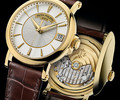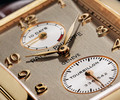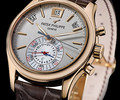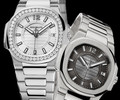The Patek Philippe Seal also reflects the tradition of innovation
The new standard of quality for mechanical watches: the Patek Philippe Seal
| Rating: 51 %1000 with 157 votes |
 Yes 2
Yes 2  Not so much 0
Not so much 0
- Summary
- The Patek Philippe Seal
- The Patek Philippe Seal also reflects the tradition of innovation
- The Patek Philippe Seal regulations
In its quest for the highest possible level of quality, the manufacture does not tolerate compromise. This is why all qualitative aspects are subject to constant refinement. Patek Philippe strives to enhance value and long-term reliability. Thus, the Patek Philippe Seal is a dynamic quality label: its set of rules accommodates current and future developments that are suitable for the advancement of timekeeping.
The Patek Philippe Seal is the personal commitment of a family business
The Patek Philippe Seal is a promise personally backed by the company’s current President Philippe Stern as well as by his designated successor, Vice President Thierry Stern. They are both members of the family that has owned Patek Philippe since 1932. They represent the third and fourth generations that have grown up with and in the manufacture. They embody the genes of Patek Philippe, serve the company with unbridled enthusiasm, and like their forefathers are committed to handing its legacy down to the next generation, a tradition most Patek Philippe customers follow with their watches.
The Patek Philippe Seal is a comprehensive quality label
The Patek Philippe Seal defines the quality specifications from the initial production steps all the way to delivery, and it is also the industry’s first promise of lifetime service. Patek Philippe guarantees that all watches it has delivered since the company was founded in 1839 will be serviced and restored.
The Patek Philippe Seal additionally guarantees the quality of all materials used. This applies to metal alloys for movement parts and to precious metals. Precious stones for jewelry watches are always of the finest quality. As for the diamonds, the manufacture selects only superbly cut, flawless, pure white Top Wesselton grades. All stones are set by masters of the jeweler’s art and under no circumstances ever adhesively bonded.
In addition to the aesthetic requirements, one extremely important quality criteria of the Patek Philippe Seal is the absolute geometric fidelity of all watch parts. This means that manual operations such as deburring, smoothing, and polishing must not alter the prescribed final dimensions or deviate from the original functionality-defining master template. No matter how complex their shape, cases must not have any sharp edges or protruding precious stones that could cause scratches. Purely decorative finishes, regardless of the parts or external elements involved, cannot compromise functional reliability in any way.
The time measurement function is always the top priority in the development, production, and completion of the movements. For instance, the shapes and configurations of the bridges that stabilize the wheel trains are not specified on the basis of aesthetic criteria. The sole motive is to achieve the greatest possible efficiency in the transmission of power from the spring barrel to the escapement with the lowest possible loss of torque to friction.
To bring out the optimum aesthetic from this function-related movement, architecture is an essential element of the art of haute horlogerie as practiced and refined by Patek Philippe. Masters of their craft lavish their talents on the movement by chamfering and mirror-polishing the edges of the bridges and plates. They adorn visible sides of the bridges with Geneva striping and apply overlapping perlage spots to their inner sides as well as to the plate. The result: movements that represent the benchmark for the entire watchmaking community in regards to their mechanical functionality, long-term reliability, rate accuracy, and aesthetic appeal.
The cases of Patek Philippe watches also possess an indispensable function. They must protect the precious mechanical movement while assuring that the timepiece is convenient to use.
This systematic quest for quality applies to all exterior elements as well, in particular to the cases. For instance, traditional cold-forming techniques are deployed to shape cases from solid metal billets in high-tonnage presses. The respective ram and die sets are fashioned in the manufacture’s in-house tooling shop from extra-hard steel to an accuracy of just a few thousandths of a millimeter. The subsequent casemaking steps are equally meticulous: including manual finishing and repetitive precision measurements. In the end, each case is polished by hand. This operation requires two hours of concentrated work for a simple steel case and as many as six hours for complex platinum cases.
The outcome is a watch case that comes as close to perfection in functionality and beauty.
Quality assurance as an integrated element of manufacturing
The Patek Philippe Seal manifests the dedication to perfection that has always set the manufacture apart from others. It not only imposes strict requirements regarding the quality of the internal and external parts of a watch but also prescribes the systematic documentation of inspections that require compliance with quality specifications to be verified after each manufacturing step. This can be illustrated using the example of a self-winding movement whose components are fashioned in about 1200 production steps and which involves several hundred hours of exhaustive inspections (parts and preassembled parts at all workstations, statistical quality controls, final inspections). Depending on their complexity, finished movements are tested for as many as 30 days, and after casing, the complete watch is returned to the test bench to assess its accuracy, functional integrity, and performance in kinetic simulators. This phase lasts up to 20 days and assures that all final assembly steps were also in compliance with the highest horological standards. The water-resistance of the watch is tested in air with overpressure as well as under water at pressures ranging from 3 to 12 bar depending on the model. The condensation test that follows is the last step in the water-resistance screening sequence. After the complete watch has successfully passed all of these tests and complies with Patek Philippe’s rate-accuracy requirement, it is visually inspected for flawlessness of appearance one last time, then vacuum-packed and readied for delivery.
The Patek Philippe Seal applies to watches that do not exist yet. Every time a new model is developed, the key issues are its function as a measuring instrument and the need for easily legible indications. The silhouette of the movement and the integration of its functions within a reasonable diameter are guiding factors as well, because despite the current trend toward ever bulkier wristwatches, Patek Philippe places emphasis on timeless elegance. In the short term, this may not always meet the market’s capricious aesthetic preferences, but Patek Philippe knows from 170 years of experience that lasting value can only be created with confidence in matters of style and with deep respect for the principles that define the heritage of watchmaking.








